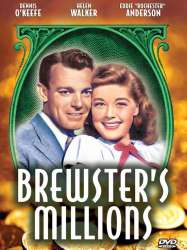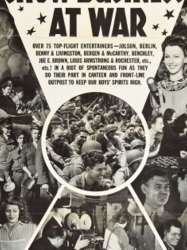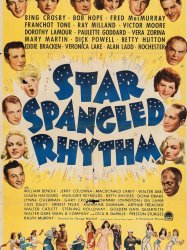Eddie Anderson is a Actor American born on 18 september 1905 at Oakland (USA)

Edmund Lincoln Anderson (September 18, 1905 – February 28, 1977) was an American comedian and actor.
Anderson got his start in show business as a teenager on the vaudeville circuit. In the early 1930s, he transitioned into films and radio. In 1937, he began his most famous role of Rochester van Jones, usually known simply as "Rochester", the valet of Jack Benny, on his radio show The Jack Benny Program. Anderson became the first African American to have a regular role on a nationwide radio program. When the series moved to television, Anderson continued in the role until the series' end in 1965.
After the series ended, Anderson remained active with guest starring roles on television and voice work in animated series. He was also an avid horse-racing fan who owned several race horses and worked as a horse trainer at the Hollywood Park Racetrack.
Anderson was married twice and had four children. He died of heart disease in February 1977 at the age of 71.
In 1932, Anderson married Mamie (Wiggins) Nelson. She was the daughter of Alonzo and Annie Wiggins of Eastman, GA.
Mamie died on August 5, 1954, at the age of 43, following a two-year battle with cancer. At the time of her death she and Anderson had been married for 22 years and her son Billy (Anderson's stepson) was playing professional football for the Chicago Bears. Billy was born George Billy Nelson to Mamie Wiggins and her previous husband on March 8, 1929, in Los Angeles, CA When Mamie married Eddie Anderson, Billy was adopted and took the surname Anderson.
Following Mamie's death Anderson married Evangela "Eva" Simon on February 8, 1956, at Kingman, Arizona. The couple had three children: daughters Stephanie and Evangela, Jr. ("Eva"), and son Edmund, Jr. Simon and Anderson divorced in 1973 with Anderson retaining custody of his minor son and daughter.
Home
Like many of the African-Americans in the entertainment industry, Anderson made his home in the West Adams district of Los Angeles. In previous times, the district had been home to doctors, lawyers, and railroad barons. In the Depression era, the area had fallen into hard times, with many residents needing to either sell their homes or rent out rooms in them. By the 1940s, the African-American entertainment community began purchasing homes in the district, nicknaming it "Sugar Hill". Some property owners reacted to their new neighbors by adding restrictive covenants to their deeds. The covenants either prohibited African-Americans from purchasing a property or inhabiting it once purchased. The practice was declared illegal by the US Supreme Court in 1948.
Since Anderson wanted to build a home designed by Paul Williams, he was limited in his choice of a site for it by these restrictive covenants. As a result, his large and luxurious home with a swimming pool where the neighborhood children were always welcome, stands in an area of smaller, bungalow-style homes. The street was renamed because 'Rochester' lived on it.
Hobbies
Anderson built model airplanes and racing cars, but also designed a life-size sports car for himself in 1951. Anderson combined a Cadillac engine under the hood and a sleek, low-slung exterior to create a car he both drove and exhibited at various sports car shows throughout the country.
Anderson, who was the skipper of his own cabin cruiser, was missing and feared lost at sea in February, 1946. When the boat developed engine trouble, Anderson and his two friends did everything sailors are expected to do to signal an SOS. They used mirrors, built fires, used lanterns and flew the ship's flag upside-down to indicate they were in distress. They spent the night adrift until a fishing boat finally spotted them and towed them into Los Angeles harbor. Anderson did not realize he had caused great concern until he heard a news story on the radio that described the search for him as still continuing. On the following Sunday, Anderson was back on the "Lucky Strike Program," and joked with Jack Benny about the incident. ("That's the first time I ever had a 'lost weekend' on nothing but water!")
Horse racing
Anderson was the owner of racehorses. The best known of them was Burnt Cork, a Thoroughbred that ran in the 1943 Kentucky Derby, making him the first African-American owner of a horse entered into the Derby. Having been given the following day off by Benny, Anderson and his wife, Mamie, traveled to Louisville, Kentucky to see their horse run in the Derby. Since segregation in public accommodations was practiced there, the Andersons were invited to be guests at the home of Mae Street Kidd, a noted female African-American Kentucky politician.
Both before and after the race, Anderson was accused of entering his horse in the race strictly for publicity purposes for himself, especially after Burnt Cork finished last. Those making the statements believed this tarnished the name and history of the race. Jack Cuddy, a United Press International sports columnist, pointed out in his column that around the same time Burnt Cork ran last for Anderson, King George VI's horse, Tipstaff, finished last at Ascot without any of the comments that surrounded Anderson.
When Burnt Cork won an important race, Anderson came to Metro-Goldwyn-Mayer for work dressed as a Kentucky colonel; he also insisted on being called "Colonel Rochester".
After the Benny television show had left the air, Anderson turned back to his love of horses and racing, working as a trainer at the Hollywood Park Racetrack until shortly before his death. He acquired much of his knowledge when one of his racing horses, Up and Over, was injured in a fall; it was suggested that the horse be euthanized due to the extent of those injuries. Anderson refused this and said he would take care of his injured animal. He spent extensive periods of time at the Paramount Pictures studio library, reading everything in their collection on equine anatomy. This led Anderson to a veterinary surgeon who was interested in helping Up and Over; together the two men brought the thoroughbred back on his feet again.
Source : Wikidata
Eddie Anderson

Birth name Edmund Lincoln Anderson
Nationality USA
Birth 18 september 1905 at Oakland (USA)
Death 28 february 1977 (at 71 years) at Los Angeles (USA)
Nationality USA
Birth 18 september 1905 at Oakland (USA)
Death 28 february 1977 (at 71 years) at Los Angeles (USA)
Edmund Lincoln Anderson (September 18, 1905 – February 28, 1977) was an American comedian and actor.
Anderson got his start in show business as a teenager on the vaudeville circuit. In the early 1930s, he transitioned into films and radio. In 1937, he began his most famous role of Rochester van Jones, usually known simply as "Rochester", the valet of Jack Benny, on his radio show The Jack Benny Program. Anderson became the first African American to have a regular role on a nationwide radio program. When the series moved to television, Anderson continued in the role until the series' end in 1965.
After the series ended, Anderson remained active with guest starring roles on television and voice work in animated series. He was also an avid horse-racing fan who owned several race horses and worked as a horse trainer at the Hollywood Park Racetrack.
Anderson was married twice and had four children. He died of heart disease in February 1977 at the age of 71.
Biography
Marriages and childrenIn 1932, Anderson married Mamie (Wiggins) Nelson. She was the daughter of Alonzo and Annie Wiggins of Eastman, GA.
Mamie died on August 5, 1954, at the age of 43, following a two-year battle with cancer. At the time of her death she and Anderson had been married for 22 years and her son Billy (Anderson's stepson) was playing professional football for the Chicago Bears. Billy was born George Billy Nelson to Mamie Wiggins and her previous husband on March 8, 1929, in Los Angeles, CA When Mamie married Eddie Anderson, Billy was adopted and took the surname Anderson.
Following Mamie's death Anderson married Evangela "Eva" Simon on February 8, 1956, at Kingman, Arizona. The couple had three children: daughters Stephanie and Evangela, Jr. ("Eva"), and son Edmund, Jr. Simon and Anderson divorced in 1973 with Anderson retaining custody of his minor son and daughter.
Home
Like many of the African-Americans in the entertainment industry, Anderson made his home in the West Adams district of Los Angeles. In previous times, the district had been home to doctors, lawyers, and railroad barons. In the Depression era, the area had fallen into hard times, with many residents needing to either sell their homes or rent out rooms in them. By the 1940s, the African-American entertainment community began purchasing homes in the district, nicknaming it "Sugar Hill". Some property owners reacted to their new neighbors by adding restrictive covenants to their deeds. The covenants either prohibited African-Americans from purchasing a property or inhabiting it once purchased. The practice was declared illegal by the US Supreme Court in 1948.
Since Anderson wanted to build a home designed by Paul Williams, he was limited in his choice of a site for it by these restrictive covenants. As a result, his large and luxurious home with a swimming pool where the neighborhood children were always welcome, stands in an area of smaller, bungalow-style homes. The street was renamed because 'Rochester' lived on it.
Hobbies
Anderson built model airplanes and racing cars, but also designed a life-size sports car for himself in 1951. Anderson combined a Cadillac engine under the hood and a sleek, low-slung exterior to create a car he both drove and exhibited at various sports car shows throughout the country.
Anderson, who was the skipper of his own cabin cruiser, was missing and feared lost at sea in February, 1946. When the boat developed engine trouble, Anderson and his two friends did everything sailors are expected to do to signal an SOS. They used mirrors, built fires, used lanterns and flew the ship's flag upside-down to indicate they were in distress. They spent the night adrift until a fishing boat finally spotted them and towed them into Los Angeles harbor. Anderson did not realize he had caused great concern until he heard a news story on the radio that described the search for him as still continuing. On the following Sunday, Anderson was back on the "Lucky Strike Program," and joked with Jack Benny about the incident. ("That's the first time I ever had a 'lost weekend' on nothing but water!")
Horse racing
Anderson was the owner of racehorses. The best known of them was Burnt Cork, a Thoroughbred that ran in the 1943 Kentucky Derby, making him the first African-American owner of a horse entered into the Derby. Having been given the following day off by Benny, Anderson and his wife, Mamie, traveled to Louisville, Kentucky to see their horse run in the Derby. Since segregation in public accommodations was practiced there, the Andersons were invited to be guests at the home of Mae Street Kidd, a noted female African-American Kentucky politician.
Both before and after the race, Anderson was accused of entering his horse in the race strictly for publicity purposes for himself, especially after Burnt Cork finished last. Those making the statements believed this tarnished the name and history of the race. Jack Cuddy, a United Press International sports columnist, pointed out in his column that around the same time Burnt Cork ran last for Anderson, King George VI's horse, Tipstaff, finished last at Ascot without any of the comments that surrounded Anderson.
When Burnt Cork won an important race, Anderson came to Metro-Goldwyn-Mayer for work dressed as a Kentucky colonel; he also insisted on being called "Colonel Rochester".
After the Benny television show had left the air, Anderson turned back to his love of horses and racing, working as a trainer at the Hollywood Park Racetrack until shortly before his death. He acquired much of his knowledge when one of his racing horses, Up and Over, was injured in a fall; it was suggested that the horse be euthanized due to the extent of those injuries. Anderson refused this and said he would take care of his injured animal. He spent extensive periods of time at the Paramount Pictures studio library, reading everything in their collection on equine anatomy. This led Anderson to a veterinary surgeon who was interested in helping Up and Over; together the two men brought the thoroughbred back on his feet again.
Usually with
Filmography of Eddie Anderson (51 films)
Actor
 , 2h13
, 2h13Directed by Gene Kelly
Origin USA
Genres Documentary, Musical
Themes Films about films, Films about music and musicians, Documentary films about business, Documentary films about the film industry, Documentary films about cities, Musical films, Documentary films about films
Actors Fred Astaire, Gene Kelly, Bud Abbott, Lou Costello, Lew Ayres, Stan Laurel
Roles (archive footage)
Rating72%





Gene Kelly et Fred Astaire présentent les meilleurs moments des films de la MGM.

Watermelon Man (1970)
, 1h40Directed by Melvin Van Peebles
Origin USA
Genres Drama, Comedy, Comedy-drama
Themes Films about racism
Actors Godfrey Cambridge, Estelle Parsons, Melvin Van Peebles, Howard Caine, Mae Clarke, D'Urville Martin
Rating66%





Jeff Gerber (Godfrey Cambridge) lives in an average suburban neighborhood with his seemingly liberal housewife Althea (Estelle Parsons), who tolerates her husband's character flaws out of love. Every morning when Jeff wakes up, he spends some time under a tanning machine, hits the speedbag, drinks a health drink, and races the bus to work on foot.
 , 2h34
, 2h34Directed by Stanley Kramer, Carey Loftin
Origin USA
Genres Drama, Comedy, Action, Adventure, Crime
Themes Transport films, Films about automobiles, Road movies, Heist films, Chase films, Gangster films, Escroquerie
Actors Spencer Tracy, Milton Berle, Sid Caesar, Buddy Hackett, Dorothy Provine, Moe Howard
Roles Second Cab Driver
Rating74%





"Smiler" Grogan (Jimmy Durante), wanted by police in a tuna factory robbery fifteen years ago and on the run from the police, careens his 1957 Ford Victoria off twisting, mountainous State Highway 74 near Palm Springs in Southern California and crashes. Five motorists stop to help him - Melville Crump (Sid Caesar), a dentist, Lennie Pike (Jonathan Winters), a furniture mover, Dingy Bell (Mickey Rooney) and Benjy Benjamin (Buddy Hackett), two friends on their way to Las Vegas, and J. Russell Finch (Milton Berle), who owns Pacific Edible Seaweed Company in Fresno. Just before he dies, Grogan tells the five about $350,000 buried in Santa Rosita State Park near the Mexican border under a mysterious "big W".

The Mouse That Jack Built (1959)
, 6minutesDirected by Robert McKimson
Origin USA
Genres Comedy, Animation
Actors Mel Blanc, Jack Benny, Mary Livingstone, Eddie Anderson
Roles Rochester (voice)
Rating73%






The Show-Off (1946)
, 1h23Directed by Harry Beaumont
Origin USA
Genres Comedy
Themes Films based on plays
Actors Red Skelton, Marilyn Maxwell, Marjorie Main, Marshall Thompson, George Cleveland, Virginia O'Brien
Roles Eddie
Rating60%





Amy Fisher's parents can't understand what their daughter sees in Aubrey Piper, a loudmouth and braggart who pretends to be more than the lowly clerk he is.

Brewster's Millions (1945)
, 1h19Directed by Allan Dwan, John E. Burch
Origin USA
Genres Comedy
Actors Dennis O'Keefe, Helen Walker, June Havoc, Eddie Anderson, Gail Patrick, Mischa Auer
Roles Jackson
Rating65%





Montague L. Brewster (Dennis O'Keefe), a newly discharged U.S. soldier back from fighting in Europe during World War II, rushes home in New York City to marry his sweetheart, Peggy Gray (Helen Walker). However, he has to postpone the wedding after he learns of a strange windfall.

The Sailor Takes a Wife (1945)
Directed by Richard Whorf
Origin USA
Genres Comedy, Romantic comedy, Romance
Themes Political films, Films based on plays
Actors Robert Walker, Eddie Anderson, June Allyson, Reginald Owen, Gerald Oliver Smith, Audrey Totter
Roles Harry
Rating60%






Broadway Rhythm (1944)
, 1h55Directed by Roy Del Ruth
Genres Comedy, Musical theatre, Musical, Romance
Themes Musical films, Films based on plays, Films based on musicals
Actors George Murphy, Charles Winninger, Gloria DeHaven, Lena Horne, Nancy Walker, Ben Blue
Roles Eddie
Rating59%






Cabin in the Sky (1943)
, 1h38Directed by Vincente Minnelli, Busby Berkeley
Origin USA
Genres Drama, Fantasy, Musical
Themes Films about music and musicians, Théâtre, Musical films, Films based on plays, Films based on musicals
Actors Ethel Waters, Eddie Anderson, Lena Horne, Rex Ingram, Oscar Polk, Mantan Moreland
Roles Joseph 'Little Joe' Jackson
Rating70%





Little Joe, a man killed over gambling debts, is restored to life by angelic powers and given six months to redeem his soul and become worthy of entering Heaven—otherwise he will be condemned to Hell. Secretly guided by "The General" (the Lord's Angel), Little Joe gives up his shiftless ways and becomes a hardworking, generous, and loving husband to his wife Petunia, whom he had previously neglected. Unfortunately, demon Lucifer Jr. (the son of Satan himself), is determined to drag Little Joe to Hell. Lucifer arranges for Joe to become wealthy by winning a lottery, reintroduces Joe to beautiful gold-digger Georgia Brown, and manipulates marital discord between Joe and Petunia. Little Joe abandons his wife for Georgia, and the two embark on a life of hedonistic pleasure. As Little Joe and Georgia celebrate at a nightclub one evening, Petunia joins them, determined to win Joe back. Little Joe fights with Domino for Petunia and she prays for God to destroy the nightclub. A cyclone appears and leaves the nightclub in ruins, as Joe and Petunia lie dead in the ruins after being shot by Domino. Just as it appears that Joe's soul is lost forever, the angelic General informs him that Georgia was so affected by the tragedy that she has donated all the money that he had given her to the church. On this technicality, Little Joe is allowed to go to Heaven with Petunia. As the two climb the Celestial Stairs, Joe suddenly wakes in his own bed. He had not been killed in the initial gambling-debt fracas—he had only received a concussion, and all his supposed dealings with angels and demons were only a fever dream. Now genuinely reformed, Little Joe begins a new, happy life with his loving Petunia.

Calling All Kids (1943)
Directed by Sam Baerwitz
Origin USA
Genres Comedy
Themes Children's films
Actors Robert Blake, Billy Laughlin, Billie "Buckwheat" Thomas, Janet Burston, Eddie Anderson, Bobby Anderson
Roles Voice-over for Buckwheat
Rating58%





Another World War II MGM Our Gang mini-musical, Calling All Kids finds the gang invading a local radio station to perform a revue honoring the U.S. military. Amidst such highlights as a "recruiting office" sketch featuring the duo of Mickey and Froggy, and a closing ensemble piece with lyrics that rhyme "Taxes" with "Axis," the film features an extended celebrity-impression routine, with Buckwheat imitating Eddie "Rochester" Anderson and other kids posing as Judy Garland, Eleanor Powell, Fred Astaire, Carmen Miranda, and Virginia O'Brien.

Show-Business at War (1943)
, 17minutesOrigin USA
Genres Documentary
Themes Documentary films about business, Documentary films about the film industry, Documentary films about war, Documentary films about historical events, Documentary films about cities, Political films, Documentary films about World War II
Actors Carole Lombard, Irving Berlin, Alfred Lunt, Loretta Young, Walt Disney, John Ford
Roles Self
Rating70%






The Meanest Man in the World (1943)
, 57minutesDirected by Sidney Lanfield
Genres Comedy
Themes Théâtre, Films based on plays, Children's films
Actors Jack Benny, Priscilla Lane, Eddie Anderson, Edmund Gwenn, Anne Revere, Margaret Seddon
Roles Shufro
Rating63%





Richard Clarke is a lawyer with his own legal practice in Pottsville, New York. His black paralegal assistant continuously claims that Clarke is far too nice a man to be a profitable businessman, since he always fails to demand payment from his poor clients and never take on those he doesn't believe are innocent. But Clarke's main problem is that he is hopelessly in love with the lovely Janie Brown. Janie's wealthy father has decided that Janie will marry the even wealthier bachelor Bill Potts. Clarke remains completely oblivious of this fact.

Tales of Manhattan (1942)
, 2h7Directed by Julien Duvivier
Origin USA
Genres Drama, Comedy, Comedy-drama, Romance
Themes Children's films
Actors Charles Boyer, Rita Hayworth, Ginger Rogers, Henry Fonda, Charles Laughton, Edward G. Robinson
Roles Rev. Lazarus
Rating72%





Based on the Mexican writer Francisco Rojas González's novel, Historia de un frac ("Story of a Tailcoat"), the stories follow a black formal tailcoat as it goes from owner to owner, in five otherwise unconnected stories.

Star Spangled Rhythm (1942)
, 1h39Directed by Ralph Murphy, George Marshall, Frank Tuttle, A. Edward Sutherland, Lewis Allen
Origin USA
Genres Comedy, Musical
Themes Films about music and musicians, Musical films
Actors Betty Hutton, Eddie Bracken, Victor Moore, Walter Abel, Anne Revere, Cass Daley
Roles Rochester
Rating65%





Pop Webster (Victor Moore) is a former silent movie star once known as "Bronco Billy" who now works as the guard on the main gate at Paramount Pictures. However, he's told his son Johnny (Eddie Bracken), who's in the Navy, that he's the studio's Executive Vice President in Charge of Production. When Johnny shows up in Hollywood on shore leave, Pop and the studio's switchboard operator Polly Judson (Betty Hutton) go all-out to maintain the illusion for Johnny and his sailor friends that Pop's a studio big-wig. Things get a bit complicated when Pop offers to put on a variety show for the Navy, featuring all of Paramount's stars, but Polly convinces Bob Hope and Bing Crosby to do the show, and they convince the rest of the stars on the lot.

Birth of the Blues (1941)
, 1h27Directed by Victor Schertzinger, Hal Walker, Alvin Ganzer
Origin USA
Genres Musical, Romance
Themes Films about music and musicians, Musical films
Actors Bing Crosby, Mary Martin, Brian Donlevy, Carolyn Lee, Eddie Anderson, J. Carrol Naish
Roles Louey
Rating62%





Jeff grandit près de Basin Street à la Nouvelle-Orléans, jouant de sa clarinette avec les dockers. Il monte un groupe, les Basin Street Hot-Shots, qui comprend un joueur de cornet, Memphis. Ils luttent pour que leur musique jazz soit acceptée par la société des cafés de la ville. Betty Lou rejoint leur groupe en tant que chanteuse. Memphis et Jeff tombent amoureux d'elle.
 Connection
Connection



